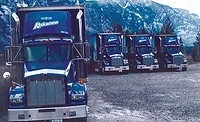Tips for Winter Weather Driving
Tips for Winter Weather Driving
David Kolman
Winter is the most difficult driving season. Not only are there colder temperatures, there also are fewer hours of daylight. Add winter weather such as snow, sleet and/or freezing rain — all of which limit visibility — and driving becomes even more challenging. Compounding the situation are a dirty windshield and worn wiper blades, which further reduce the range of view.
There are, nevertheless, effective measures that can
be taken to minimize the risks, say safety professionals. These center on
extra alertness, awareness of road and weather conditions and an adjustment
in driving techniques.
First and foremost, the professionals note, is the
importance of driving appropriately for conditions, particularly in
unfamiliar areas and on curves and turns. As you might expect, driving too
fast for conditions is the leading cause of winter driving accidents.
They further advise checking on road and weather
conditions before planning a trip and beginning driving. It is a good idea
to allow for extra traveling time, they add.
Be extra cautious during the first few minutes of snow
or rain because roadways get slippery when
precipitation mixes with oil, grease and dirt, warn safety professionals.
Wet leaves can be especially slippery and hazardous, as well.
Additional winter driving tips:
AT THE WHEEL
• Avoid distracting
activities such as using a cell phone — even if you use a headset.
• Drive defensively. Be at the ready to take evasive
action to safely deal with other drivers’ mistakes.
• Do not use cruise control. Winter driving requires a
driver to be in full control at all times.
• Look farther ahead in traffic than you normally do.
Actions by vehicles ahead will alert you to problems faster, giving you
extra time to react safely.
• Increase following distance between you and the
vehicle ahead. It takes three to 12 times more stopping distance on ice and
snow. The heavier the vehicle, the greater the stopping distance.
What’s more, by increasing your following distance you help reduce
visibility problems from spraying snow and ice.
• Signal your turns well in advance to give other
drivers increased warning.
MANEUVERS
• Start slowing down well before a stop. Gearing down
assists in decelerating gradually.
• Braking on snow and ice is never easy, but as the
temperature rises, snow and ice become even more slippery. Check the feel
of the road when you start out and at regular intervals.
• Accelerate slowly and easily, and refrain from sudden
or jerky movements to avoid loss of traction and subsequent loss of
control.
• Use extra caution when approaching curves and hills,
before making turns and when driving from a well-traveled highway to a
less-traveled highway.
• Reduce speed when approaching intersections covered
with ice or snow.
• Be very careful when approaching shaded areas, bridges
and overpasses, as ice forms on them much sooner than on the roadway.
• Be on the lookout for “black ice,” a
condition in which ice forms on a roadway when temperatures are near or
below freezing. Nearly invisible, black ice can cause a vehicle to lose
traction suddenly. An indication of black ice is a road surface that
appears black and shiny.
• Watch mirror faces and antenna for ice buildup. When
these become ice-coated, the road surface will usually soon follow.
LIGHTS
• Use your vehicle’s low-beam headlights. High
beams reflect rain, sleet and falling snow and can actually make it more
difficult to see clearly.
• Use “fog lights” in any weather conditions
that restrict your visibility.
• Be certain all your lights work and keep them clean so
as to better see and be seen.
• Make sure headlights are properly aimed. Misaligned
headlights can reduce your visibility and blind other drivers.
WINDOWS & WIPERS
• Keep the windshield and windows clean — inside
and out. A dirty windshield magnifies glare from approaching headlights.
• Keep windshield wiper blades in good working
condition. Inspect them frequently. When worn or damaged, wipers blades not
only impair visibility, they can damage the windshield.
• Do not use windshield wipers to try and clear ice and
snow after a vehicle has been sitting for a period of time. The wiper
system was never intended to be an ice scraper. Using it as such could
damage its components.
• Keep the windshield washer reservoir full with washer
fluid. Use washer fluids that have anti-freeze and cleaning properties.
It’s wise to carry at least one spare bottle of washer fluid on
board.
David Kolman is a veteran truck communicator, keynote
speaker and long-haul trucker. Commissioned as an Honorary Colonel on the
Kentucky governor’s staff for his work promoting traffic safety, he
actively participates in trade associations and reports news and
information about the trucking industry for broadcasting and print media.
Know your winter weather
Winter storms can often cause severe travel problems.
Always check weather conditions for your travel route and time of day
before you begin driving, recommend safety professionals. Stay abreast of
weather and road condition reports by listening to the radio, monitoring
weather channels and checking with others who have come from your direction
of travel.
Understanding winter weather terms can help you plan
accordingly. Listed below are some commonly used terms:
Winter Storm Watch —
A long range prediction issued when conditions are favorable for hazardous
winter weather, such as heavy snow, sleet or freezing rain. A watch usually
is issued at least 24 to 36 hours in advance.
Winter Storm Warning —
A warning is issued when a dangerous combination of heavy snow with sleet
and/or freezing rain has a high probability of occurring within 6 to 12
hours.
Winter Weather Advisory —
An advisory is issued when lesser accumulations of snow, sleet and/or
freezing rain are expected to cause only an inconvenience.
Snow Advisory —
A snow advisory is issued when accumulations of 3 inches of snow or less
are anticipated.
Sleet Warning —
A sleet warning is issued when sleet accumulations of less than half an
inch are expected.
Wind Chill Warning —
A warning that is issued when cold temperatures with wind are life
threatening.
Wind Chill Advisory —
An advisory that is issued when life-threatening cold temperatures with
wind are expected.
Looking for a reprint of this article?
From high-res PDFs to custom plaques, order your copy today!




